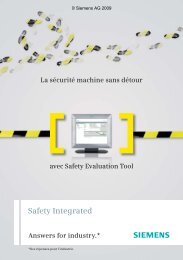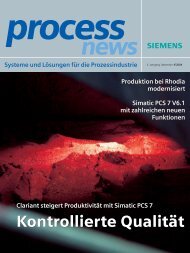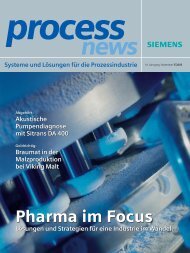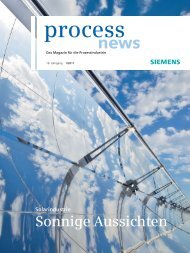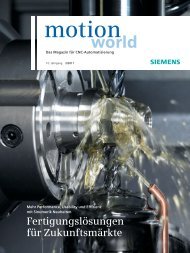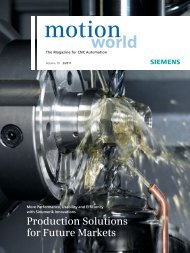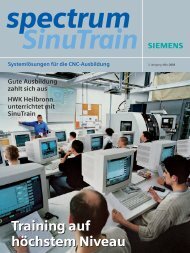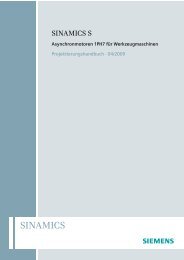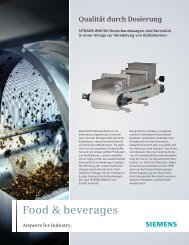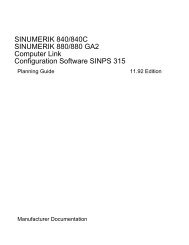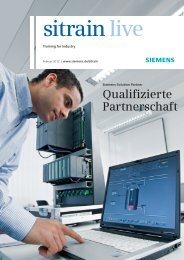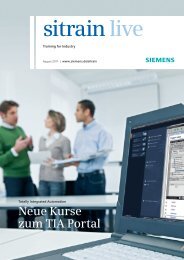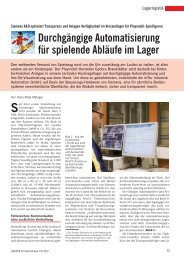Engineering System - Siemens Automation and Drives Group
Engineering System - Siemens Automation and Drives Group
Engineering System - Siemens Automation and Drives Group
Create successful ePaper yourself
Turn your PDF publications into a flip-book with our unique Google optimized e-Paper software.
10<br />
<strong>Automation</strong> systems<br />
Fault-tolerant automation systems<br />
■ Overview<br />
Fault-tolerant automation systems are used to minimize the risk<br />
of production failures. The higher investment in fault-tolerant automation<br />
systems is often negligible compared to the costs resulting<br />
from production stoppages. The higher the costs resulting<br />
from loss of production, the more important a fault-tolerant<br />
system becomes.<br />
■ Design<br />
The AS 414-4-1H <strong>and</strong> AS 417-4-1H automation systems are initially<br />
equipped with just one CPU. They are used in particular<br />
when the redundant subsystems have to be physically separated<br />
from one another for safety reasons or when the customer<br />
would like to keep open his options for a redundant configuration<br />
in the future. The failsafe AS 414F <strong>and</strong> AS 417F automation systems<br />
are based likewise on this hardware in the corresponding<br />
version.<br />
There are two configuration possibilities for the AS 414-4-1H <strong>and</strong><br />
AS 417-4-1H automation systems:<br />
Configuration with two st<strong>and</strong>ard subracks (UR1 or UR2)<br />
This configuration is ideal when the two redundant subsystems<br />
have to be completely separated for availability reasons.<br />
Each subsystem contains a CPU, a potentially redundant<br />
power supply module (AC), <strong>and</strong> a communication<br />
module for Industrial Ethernet.<br />
Configuration with a UR2-H subrack<br />
The UR2-H compact subrack with split backplane bus is suitable<br />
for configuring a complete fault-tolerant automation system.<br />
For the AS 414-4-1H <strong>and</strong> AS 417-4-1H the UR2-H is<br />
equipped with a CPU, a potentially redundant power supply<br />
module <strong>and</strong> a communications module for Industrial Ethernet.<br />
In the case of the redundant AS 414-4-2H <strong>and</strong> AS 417-4-2H automation<br />
systems, the two subsystems are accommodated in<br />
the UR2-H subrack. Each subsystem is equipped with a CPU, a<br />
potentially redundant power supply module <strong>and</strong> a communications<br />
module for Industrial Ethernet.<br />
In all the configurations described, potentially redundant power<br />
supply modules can be exp<strong>and</strong>ed to redundant configuration by<br />
retrofitting a second power supply module of the same type.<br />
Another 4 sync modules <strong>and</strong> 2 sync cables have to be ordered<br />
in addition to create a redundant system from two AS 414-4-1H<br />
or AS 417-4-1H automation system (UR1/UR2 subracks) <strong>and</strong> to<br />
subsequently exp<strong>and</strong> an AS 414-4-1H or AS 417-4-1H in a UR2-<br />
H subrack into a redundant AS 414-4-2H or AS 417-4-2H system.<br />
10/6<br />
<strong>Siemens</strong> ST PCS 7 · October 2004<br />
Connection of process I/Os<br />
Several PROFIBUS DP lines with distributed process I/Os can be<br />
operated on each sub-AS through the internal PROFIBUS DP interface<br />
or by using additional communications processors.<br />
The distributed ET 200M I/Os are connected through two<br />
IM 153-2 interface modules on a special bus module to two redundant<br />
PROFIBUS DP lines, <strong>and</strong> the intelligent field devices on<br />
the PROFIBUS PA are connected through a redundant<br />
DP/PA link with two IM 157 interface modules. The Y-link can<br />
also be used to connect non-redundant PROFIBUS DP devices<br />
to the redundant PROFIBUS DP.<br />
A mixture of these configurations is also possible.<br />
Communication through the plant bus<br />
The redundant, fault-tolerant AS 414H <strong>and</strong> AS 417H automation<br />
systems are connected by one communication module per sub-<br />
AS to the plant bus. The plant bus can be implemented in the<br />
form of a ring structure, which can also be configured with redundant<br />
architecture if the availability requirements are high.<br />
When there are two redundant rings it makes sense to use two<br />
communication module per sub-AS <strong>and</strong> to distribute their connections<br />
between the two rings. Double faults such as OSM failure<br />
on ring 1 with simultaneous splitting of the bus cable on ring<br />
2 can thus be tolerated.<br />
■ Function<br />
The AS 414H <strong>and</strong> AS 417H models are the fault-tolerant automation<br />
systems for use with SIMATIC PCS 7. They are based on the<br />
1-out-of-2 principle <strong>and</strong> switch to the backup system in the event<br />
of a fault. These systems use a completely redundant design to<br />
maximize availability. This means that all major components<br />
such as CPU, power supply <strong>and</strong> hardware for coupling the two<br />
CPUs are present in pairs. Which other components are also<br />
made available in pairs in the interest of availability depends on<br />
the particular automation task.<br />
The two subsystems of a redundant automation system are electrically<br />
isolated from one another. This increases the system stability<br />
with respect to EMC interference. A redundant automation<br />
system can be installed mechanically in a one- or two-rack architecture.<br />
<strong>Automation</strong> systems are installed in two racks, for example,<br />
if the two parts of the automation system have to be physically<br />
separated from one another by a fire-resistant wall.<br />
Appropriate complete units are available for every type of application.<br />
Mixed operation of redundant <strong>and</strong> st<strong>and</strong>ard systems is<br />
also possible.



